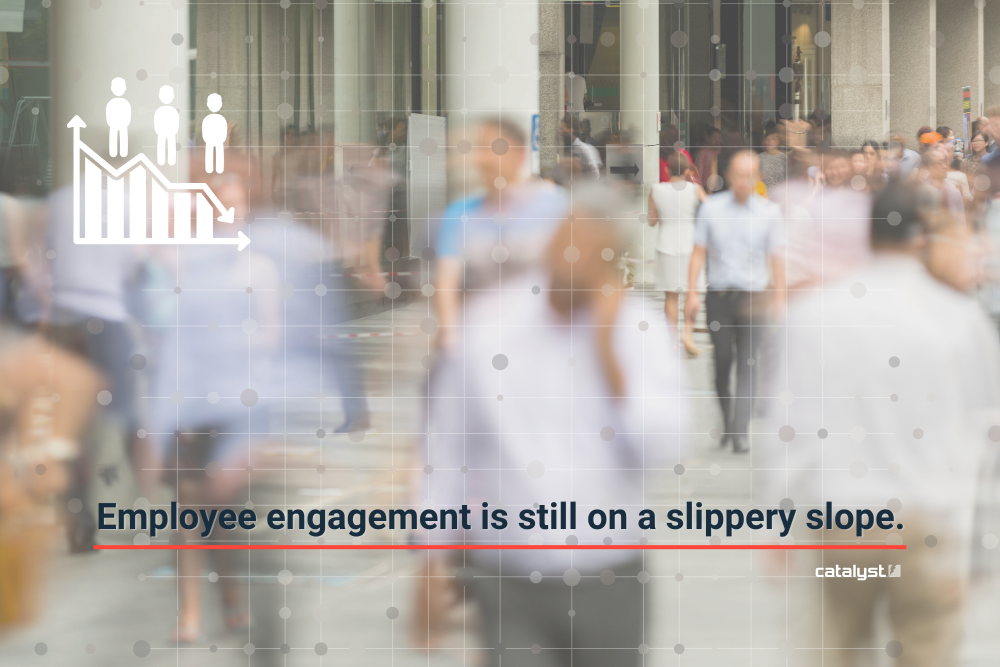Employee engagement is still on a slippery slope.
According to the State of the Global Workplace 2025 Report by Gallup, “in 2024, the global percentage of engaged employees fell from 23% to 21%.”
“Engagement has only fallen twice in the past 12 years, in 2020 and 2024,” states the report. “Last year’s two-point drop in engagement was equal to the decline during the year of COVID-19 lockdowns.”
What contributes to declining employee engagement has been tested and presented by various studies in the last 5 years. It’s up to a company’s decision makers to take those weaknesses and turn them into opportunities. We believe, that one such opportunity is to invest in an organisation-wide culture of learning and connectedness.
The Gallup report indicates that Manager-level staff are the ones to worry most about, dropping from 30% to 27% on engagement rankings.
“If manager engagement continues to decline, it won’t stop with managers, and it won’t stop with engagement. The productivity of the world’s workplace is at risk.”
Looking at Gallup’s other studies, an important factor to consider here is that ‘caring manager’ and ‘development’ are two of the five key drivers of employee engagement.
Providing basic training and development is essential for all groups of employees, including managers. In fact, Gallup states that the manager or team leader alone, accounts for 70% of the variance in team engagement.
Learning and development is directly linked to employee engagement.
In one of our blogs, we unpacked the link between employee learning and development, employee engagement and employee retention.
While there are numerous factors that contribute to overall employee experience (and consequently to their engagement and retention), we believe that two of the core ones are:
- employees understanding how they contribute to the company’s success, and
- learning and growing in the process of delivering on that
The LinkedIn Workplace Learning Report 2024 concluded that “companies with strong learning cultures see up to 57% higher rates of retention”, more internal mobility and a healthier management pipeline than those with smaller levels of commitment to learning.
Formal and informal learning.
Remember, there is formal and informal employee learning, and both are critical for your employee experience. It pays to offer a variety of relevant courses in your course catalogue as well as provide opportunities for productive collaboration with other staff and in your sector.
This comes down to various strategic decisions including your technology strategy.
Technology considerations.
Technology can help, or it can make matters worse. We discussed this in a blog previously, in relation to breaking organisational silos, which very much relates to informal employee learning and productive collaboration.
So be careful making technology decisions without consulting with workplace LMS specialists and mapping out a strategy that will serve you in the long term; aligning with your mid-to-long term strategic priorities and goals.
If your company is growing and / or working towards further expansion, you need to lay the technological foundation for that.
Many organisations get caught out by making rushed decisions when new budgets become available, adding new tools and applications without considering the complications and costs that they may face further down the track.
You can make technology choices that are flexible, extendable and cost efficient all at the same time.
If you have already been caught out with some inflexible options – whether it’s unsupported software, lock in contracts or limited integration options – you can still change things for the better by mapping out a roadmap where more efficiencies and flexibility will become possible over time, or in at least some parts of your business.
The right technological eco-system will provide online learning platforms for your staff, enable feedback, access to resources, better communication and collaboration.
Tiffani Bova, a former research fellow at Gartner, and the global growth evangelist at Salesforce, says that “seamless technology that reduces employees’ day to day friction” is one of the key factors that contributes to positive employee experience. This conclusion was based on a study of thousands of employees and executives from around the world, and across multiple industries.
“According to research my Salesforce colleagues and I conducted, a company could increase revenues by up to 50% by improving employee experience,” says Bova.
Acknowledging the problem is the first step to solving it. What contributes to declining employee engagement has been tested and presented by various studies in the last 5 years. It’s up to a company’s decision makers to take those weaknesses and turn them into opportunities.
Catalyst IT Australia specialise in enterprise level e-learning solutions. As advocates for open source software, we offer our clients flexibility, transparency and the freedom to innovate.
With over 300 specialists across the four regions – Australia, New Zealand, Europe and Canada – we bring the global perspective on the latest EdTech trends, while maintaining localised industry knowledge and support for our clients.

